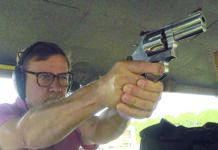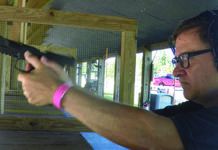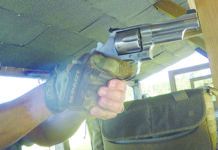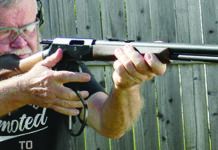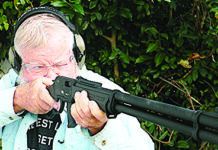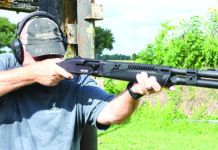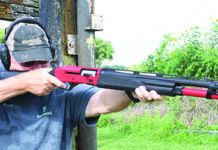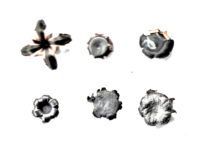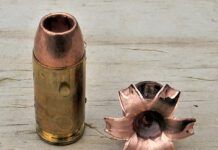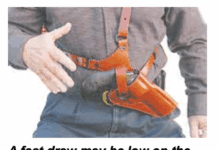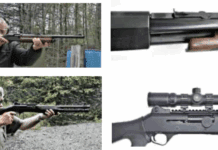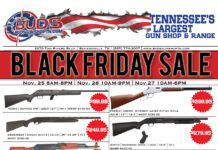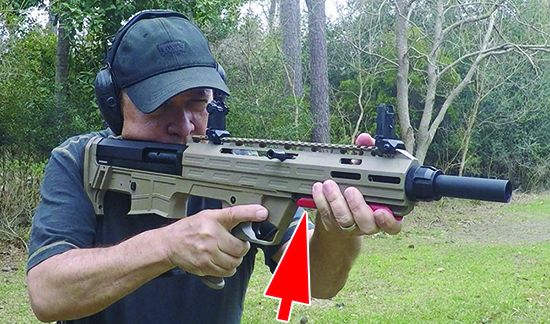Custom shotguns with competitive go-fast features aren’t affordable for many shooters, but there are some off-the-shelf guns that are designed to offer quick shooting in defense situations. Naturally, semi-automatic shotguns designed for 3-Gun competition quickly rose to the top of the list, as well as compact bullpup-style shotguns. We didn’t want to melt our credit card, so we found three scatterguns in an affordable price range from about $300 to $650. The criteria for this match up was the ability to shoot fast, engage multiple targets with speed, pattern well, offer fast reloads, and be absolutely reliable with any ammo loaded. Bonus points were given to guns that could be modified with aftermarket parts like extended magazine tubes, vertical grips, sights, and so on.
• The Stoeger M3K 3-Gun is tricked out for 3-Gun competition and is at the high end of the price spectrum at about $650.
• Next in order of cost is the Benelli M2 clone from Military Armament Corporation (MAC), the MAC 2 3-Gun at about $350.
• Finally, investing at the low end of the budget for about $279, got us the Tokarev TBP (Tokarev Bull Pup), a magazine-fed bullpup, which is not suited for 3-Gun, but is tailor-made for close-quarters defense.
All three shotguns are 3-inch 12-gauge semi-automatics compatible with Benelli Mobil choke tubes. Triggers ranged from okay to awful. The MAC and Stoeger are inertia-driven guns, and the Tokarev is gas-operated.
How We Tested
Inertia shotguns have a reputation that precedes them; namely, they jam when light target loads are used. Both the Stoeger and MAC recommend a break-in period of about 100 rounds with shells having a 1350-fps muzzle velocity, which will then allow use of light loads. The Stoeger suggests a minimum of 1-ounce 3-dram loads to be used. Dram is the archaic way of referring to the unit of measure in a black-powder charge. Not sure why the term is still printed on boxes of modern smokeless powder shells. A 3-dram load pushes a 11⁄8-ounce load of shot at about 1200 fps. The Tokarev uses a piston system and two pistons are supplied; one for standard loads and one for heavy loads, which they define as 11⁄4 ounce and heavier. We used the standard piston for testing because all the ammo was loaded with 11⁄8-ounce loads or lighter. We fired a combination of slugs, 00 buck, and No. 8 bird shot. Hornady Critical Defense 00 Buck with eight pellets has a factory muzzle velocity of 1600 fps; Sellier & Bellot 00 Buck with nine pellets has a factory velocity of 1214 fps. The birdshot loads used 11⁄8 ounces and consisted of Winchester Universal, an economy shotshell with a 3-dram load at 1200 fps. Remington Premier STS Light Target has a factory velocity of 1145 fps. We wondered if the light Remington loads would choke the inertia-driven guns. We also fired a Federal Hydra-Shok 1-ounce rifled slug with a factory muzzle velocity of 1300 fps. Each load was fired separately to see how it functioned. We also loaded a mix of shells in the same magazine. It was easy to tell what shells were what after the shot due to the difference in recoil.
We ran a form of the Casino Drill with two tombstone cardboard targets, one at 10 yards and one at 15 yards. The idea behind the Casino Drill is to test the shooter’s ability to think through a problem while still shooting for speed and accuracy and executing a reload. Typically in the Casino Drill, the user fires 10 rounds of birdshot or buckshot on four targets; one round on target one, two rounds on target two, etc. Targets are numbered 1, 3, 2, 4, to force the user to think about number of rounds required, while throwing in a reload. The drill is timed. We fired six rounds total per run, with one round on target one, two rounds target two, then repeated with reloads in between as required. We also fired the shotguns from the hip to see if that would cause a jam, especially with the inertia guns. It didn’t, but we did have jams. Finally, at 15 yards we patterned the guns on IDPA-style targets with birdshot, buckshot, and slug groups.
We reloaded the MAC and Stoeger using a J&L Dynamics Johnny Clip 2×4 12-gauge caddy (Amazon.com; $32) mounted to a Blade-Tech Tek-Lok belt-clip attachment (Amazon.com; $13). The Tek-Lok allows the user to rotate the position of the shells for economy of motion and easy access. Using the Johnny Clip offers a lot of speed, especially with bi- and quad-reloads, two rounds at a time and four rounds at a time, respectively. You pull up and out on the shells to remove them from the Johnny clip. We tried loading using our support hand to grasp the shells and reload with stock under our armpit, and reloading using our firing hand to grasp shells and reload with the stock resting on our shoulder. For the Tokarev bullpup, it was a simple magazine swap, or so we thought.
What guns had failures to feed (FTF) and failures to eject (FTE) jams? Read on to find out.
Tokarev TBP 12FDE 21000128 12 Gauge
$279
Gun Tests grade: B
The TBP choked when ejecting the Winchester shells, but it ran well on all other ammo. Recoil is moderate. The Picatinny-style top and bottom rails chew up your support hand during recoil. Reloading can be awkward. Awful, heavy trigger. Very maneuverable in tight spaces.
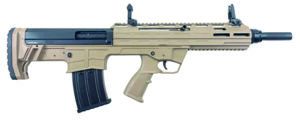
| Action Type | Semi-auto, gas operated |
| Chamber Size | 3.0 in. |
| Overall Length | 28.5 in. |
| Capacity | 5+1 |
| Weight Unloaded | 6.5 lbs. |
| Weight Loaded | 6.9 lbs. |
| Barrel | Matte blue steel, 18.5 in. long |
| Choke Tubes | Benelli Mobil; C, IC, M |
| Stock, Butt | Textured polymer, FDE finish, rubber pad |
| Stock Length of Pull | 15.6 in. |
| Stock Fore End | FDE polymer, Picatinny-style rail |
| Sights | Polymer flip-up BUIS style, optics ready |
| Trigger Pull Weight | 10.5 lbs. |
| Safety | Manual trigger block |
| Warranty | 1 year |
| Telephone | (865) 604-6894 |
| Website | TokarevUSA.com |
| Made In | Turkey |
The TBP is a bullpup design that feeds off a detachable box magazine. Compact is an apt way to describe the TBP. With the 18.5-inch barrel, the overall length is only 28.5 inches. This is a highly maneuverable shotgun that excels in tight places like hallways and vehicles. The controls are set up like an AR-15’s, so they will be familiar to those accustomed to running that rifle. It also very affordable, costing as much as some manually operated pump-action shotguns. The TBP ships with three choke tubes: Full, Modified, and Cylinder.
Bullpup designs locate the action behind the trigger, so in hand, the weight of the TBP is just behind your firing hand. You could shoot the TBP as pistol in a pinch. The safety selector can be operated with the user’s thumb, as long as you are right handed. The bolt release is like an AR-15’s and locks back the bolt on the last shot fired. The magazine release is also similar to an AR-15. The controls will seem familiar, but because the TBP is a bullpup, the bolt release and magazine catch are behind your firing hand.
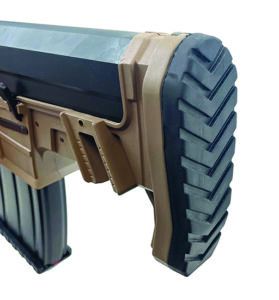
The receiver is polymer and houses the swept-back pistol grip and stock. The LOP is a long 15.6 inches, so shorter-stature users need to reach for the trigger. The recoil pad is hard rubber with large serrations that offer a bit of recoil protection. The TBP weighs 6.5 pounds, so it’s nice that the gas system helps reduce felt recoil. The handguard is also polymer and completely covers the barrel, so your support hand is protected from barrel heat during extended shooting sessions. The top and bottom of the rail feature a Picatinny-style rail that offers plenty of options to mount an optic on top or accessories on the bottom. The TBP came with a sleeve over the bottom rail, which is a good thing because the rail can chew away at your support hand like a cheese grater, similar to old-school quad rails on an AR-15. Wear a glove on your support hand or attach a vertical grip or brace to alleviate the chewing.
The polymer flip-up sights are mounted on top and are serviceable. They do not lock in place, so be aware if you are in a confined environment and shoulder the TBP for a shot. You may have accidentally folded one or both sights down.
The trigger had an awful 10.5-pound pull weight, which took some ramp-up time to master. Heavy trigger pulls are the bane of bullpups because the trigger bar is long to reach back to the action. We’ll give the TBP a pass on the trigger because we were able to semi-master it by the end of testing.
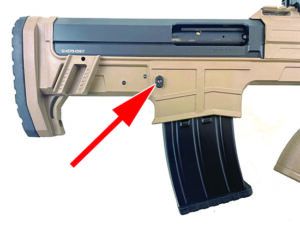
The fixed and flat charging handle on the Tokarev protrudes from the right side. We operated the charging handle with our support hand while the recoil pad was resting on our hip. We also operated it with our firing hand in a similar way.
The good news is the magazine was easy to load full with five shells. The bad news is the magazine did not fall free when the magazine release is pressed. After you press the magazine release, you need to strip the magazine from the gun. This made the TBP awkward to reload. We thought the TBP would be the fastest to reload because it uses a removable magazine, but that was not the case at all. The most efficient method to reload was to rest the recoil pad against our hip, press the mag release, remove the mag and insert a fresh one. As we shouldered the TBP, we would then press the bolt release with our support hand to send it into battery.
Running the Casino Drill was frustrating. The TBP had initial FTF jams with Winchester ammo, and then refused to eject (an FTE) the Winchester shells. Maybe the aluminum base on the inexpensive Winchester shells was the culprit, because all other ammo brands cycled and the bases were brass. With Remington light target loads, the TBP chewed through shells and shredded the cardboard targets. Recoil was moderate.
With the rifle sights, the best three-shot group with Federal Hydra-Shok slugs measured 2.1 inches. Hornady and Sellier & Bellot 00 buck patterned 3 and 11 inches, respectively. The TBP had the tightest patterns with the No. 8 birdshot, measuring 22 inches in diameter.
Our Team Said: We liked the maneuverability the TBP provided, but we thought the reload process was awkward and was something that needed to be practiced to be efficient. Reliability with other than the Winchester shells was great. The bottom rail needs a fix that can easily be accomplished with AR-15 style accessories that mount to a Picatinny-style rail. If we used this as a home-defense gun, we would make sure our load of choice cycled reliably. We also think you could mount a red dot and use a two-round magazine (TokarevUSA.com; $20) to make a compact slug gun for deer hunting.
| 12-GAUGE RANGE DATA | |||||
| Military Armament Corporation MAC 2 3-Gun (Cylinder choke tube) | Hornady Critical Defense 23⁄4 in., 00 Buckshot | Federal Hydra-Shok 23⁄4 in., 1-oz. slug | Winchester Universal 23⁄4 in. No. 8 shot | Sellier & Bellot 23⁄4 in., 00 Buckshot | Remington Premier STS Light Target 23⁄4 in., No. 8 shot |
| Average Pattern/Group Size | 4.5 in. | 1.7 in. | 26.0 in. | 9.0 in. | 26.0 in. |
| Stoeger M3K 3-Gun (Cylinder choke tube) | Hornady Critical Defense 23⁄4 in., 00 Buckshot | Federal Hydra-Shok 23⁄4 in., 1-oz. slug | Winchester Universal 23⁄4 in., No. 8 shot | Sellier & Bellot 23⁄4 in., 00 Buckshot | Remington Premier STS Light Target 23⁄4 in., No. 8 shot |
| Average Pattern/Group Size | 2.2 in. | 2.7 in. | 25.0 in. | 9.5 in. | 25.0 in. |
| Tokarev TBP 12FDE (Cylinder choke tube) | Hornady Critical Defense 23⁄4 in., 00 Buckshot | Federal Hydra-Shok 23⁄4 in., 1-oz. slug | Winchester Universal 23⁄4 in., No. 8 shot | Sellier & Bellot 23⁄4 in., 00 Buckshot | Remington Premier STS Light Target 23⁄4 in., No. 8 shot |
| Average Pattern/Group Size | 3.0 in. | 2.1 in. | 22.0 in. | 11.0 in. | 22.0 in. |
Written and photographed by Robert Sadowski, using evaluations from Gun Tests Team members. GT




